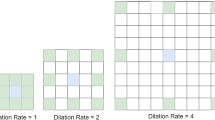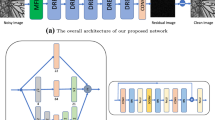Abstract
In this paper, a more effective Gaussian denoiser is designed to enhance the resulting image quality. We propose a novel image denoising method using a multiscale dilated residual network, named MDRNet. The proposed method is based on two main strategies. First, we adopt dilated convolutions in our network to enlarge the receptive field while requiring fewer parameters. The hybrid dilation rate pattern (HDP) is implemented such that each pixel in the pattern contributes similarly to the receptive field, allowing our network to learn the image details equally. Second, we employ a contextualized structure to take advantage of the low-level features which are mainly concentrated in the first two layers. Our method achieves competitive denoising performance and requires fewer parameters compared to existing denoising methods that using convolutional network. Through comprehensive experiments, we show that the denoising performance of our method is competitive with the state-of-the-art methods in terms of both quantitative and qualitative evaluation.








Similar content being viewed by others
References
Arbeláez P, Maire M, Fowlkes C, Malik J (2011) Contour detection and hierarchical image segmentation. IEEE trans Patt Anal Mach Intell 33(5):898–916
Burger HC, Schuler CJ, Harmeling S (2012) Image denoising: Can plain neural networks compete with bm3d?. In: Computer vision and pattern recognition (CVPR), 2012 IEEE Conference on. IEEE, Los Alamitos, pp 2392–2399
Chen C, Xiong Z, Tian X, Wu F (2018a) Deep boosting for image denoising. In: European Conference on Computer Vision. Springer, New York, pp 3–19
Chen J, Chen J, Chao H, Yang M (2018b) Image blind denoising with generative adversarial network based noise modeling. In: Proceedings of the IEEE Conference on Computer Vision and Pattern Recognition, pp 3155–3164
Chen Y, Pock T (2017) Trainable nonlinear reaction diffusion: a flexible framework for fast and effective image restoration. IEEE Trans Patt Anal Mach Intell 39(6):1256–1272
Cho SI, Kang SJ (2018) Geodesic path-based diffusion acceleration for image denoising. IEEE Trans Multi 20(7):1738–1750
Cho SI, Kang SJ (2019) Gradient prior-aided cnn denoiser with separable convolution-based optimization of feature dimension. IEEE Trans Multi 21(2):484–493
Cui J, Qi J, Li D (2013) A fast approximate sparse coding networks and application to image denoising. In: International Symposium on Neural Networks. Springer, New York, pp 620–626
Dabov K, Foi A, Katkovnik V, Egiazarian K (2007) Image denoising by sparse 3-d transform-domain collaborative filtering. IEEE Trans Image Process 16 (8):2080–2095
Fan Q, Zhang L (2018) A novel patch matching algorithm for exemplar-based image inpainting. Multi Tools Appli 77(9):10807–10821
Gu S, Zhang L, Zuo W, Feng X (2014) Weighted nuclear norm minimization with application to image denoising. In: Proceedings of the IEEE Conference on Computer Vision and Pattern Recognition, pp 2862–2869
He K, Zhang X, Ren S, Sun J (2015) Delving deep into rectifiers: Surpassing human-level performance on imagenet classification. In: Proceedings of the IEEE international conference on computer vision, pp 1026–1034
Huang DA, Kang LW, Yang MC, Lin CW, Wang YCF (2012) Context-aware single image rain removal. In: Multimedia and expo (ICME), 2012 IEEE International Conference on. IEEE, Los Alamitos, pp 164–169
Ioffe S, Szegedy C (2015) Batch normalization: Accelerating deep network training by reducing internal covariate shift. In: International Conference on Machine Learning, pp 448–456
Jain V, Seung S (2009) Natural image denoising with convolutional networks. In: Advances in Neural Information Processing Systems, pp 769–776
Jiao J, Tu WC, He S, Lau RW (2017) Formresnet: formatted residual learning for image restoration. In: Computer vision and pattern recognition workshops (CVPRW), 2017 IEEE Conference on. IEEE, Los Alamitos, pp 1034–1042
Krizhevsky A, Sutskever I, Hinton GE (2012) Imagenet classification with deep convolutional neural networks. In: Advances in neural information processing systems, pp 1097–1105
Levin A, Nadler B (2011) Natural image denoising: Optimality and inherent bounds. In: Computer vision and pattern recognition (CVPR), 2011 IEEE Conference on. IEEE, Los Alamitos, pp 2833–2840
Liu D, Wen B, Jiao J, Liu X, Wang Z, Huang TS (2018) Connecting image denoising and high-level vision tasks via deep learning. arXiv:180901826
Liu P, Fang R (2017) Wide inference network for image denoising via learning pixel-distribution prior. arXiv:170705414
Mao X, Shen C, Yang YB (2016) Image restoration using very deep convolutional encoder-decoder networks with symmetric skip connections. In: Advances in neural information processing systems170705414, pp 2802–2810
Munir B, Hussain SF, Noor A (2019) Speeding up the patch ordering method for image denoising. Multi Tools Appl 1–19
Roth S, Black MJ (2009) Fields of experts. Int J Comput Vis 82(2):205
Schmidt U, Roth S (2014) Shrinkage fields for effective image restoration. In: Proceedings of the IEEE Conference on Computer Vision and Pattern Recognition, pp 2774–2781
Shensa MJ (1992) The discrete wavelet transform: wedding the a trous and mallat algorithms. IEEE Trans Signal Process 40(10):2464–2482
Shi Z, Xu B, Zheng X, Zhao M (2017) A chinese character structure preserved denoising method for chinese tablet calligraphy document images based on ksvd dictionary learning. Mult Tools and Appl 76(13):14921–14936
Tai Y, Yang J, Liu X, Xu C (2017) Memnet: A persistent memory network for image restoration. In: Proceedings of the IEEE Conference on Computer Vision and Pattern Recognition, pp 4539–4547
Wang P, Chen P, Yuan Y, Liu D, Huang Z, Hou X, Cottrell G (2018) Understanding convolution for semantic segmentation. In: 2018 IEEE Winter Conference on Applications of Computer Vision (WACV). IEEE, Los Alamitos, pp 1451–1460
Wang T, Sun M, Hu K (2017) Dilated deep residual network for image denoising. In: 2017 IEEE 29Th international conference on tools with artificial intelligence ICTAI. IEEE, Los Alamitos, pp 1272–1279
Xie J, Xu L, Chen E (2012) Image denoising and inpainting with deep neural networks. In: Advances in neural information processing systems, pp 341–349
Xie J, Feris RS, Yu SS, Sun MT (2015) Joint super resolution and denoising from a single depth image. IEEE Trans Multi 17(9):1525–1537
Yu F, Koltun V (2015) Multi-scale context aggregation by dilated convolutions. arXiv:151107122
Yu F, Koltun V, Funkhouser T (2017) Dilated residual networks. In: 2017 IEEE Conference on Computer Vision and Pattern Recognition (CVPR). IEEE, Los Alamitos, pp 636–644
Zha Z, Liu X, Huang X, Shi H, Xu Y, Wang Q, Tang L, Zhang X (2017) Analyzing the group sparsity based on the rank minimization methods. In: 2017 IEEE International Conference on Multimedia and Expo (ICME). IEEE, Los Alamitos, pp 883–888
Zhang K, Zuo W, Chen Y, Meng D, Zhang L (2017) Beyond a gaussian denoiser: Residual learning of deep cnn for image denoising. IEEE Trans Image Process 26(7):3142–3155
Zhang K, Zuo W, Gu S, Zhang L (2017) Learning deep cnn denoiser prior for image restoration. In: IEEE Conference on Computer Vision and Pattern Recognition, vol 2
Zhang K, Zuo W, Zhang L (2018a) Ffdnet: Toward a fast and flexible solution for cnn based image denoising. IEEE TransImage Process
Zhang Y, Tian Y, Kong Y, Zhong B, Fu Y (2018b) Residual dense network for image restoration. arXiv:181210477
Zheng X, Miao Q, Shi Z, Fan Y, Shui W (2016) A new artistic information extraction method with multi channels and guided filters for calligraphy works. Multi Tools Appl 75(14):8719–8744
Zoran D, Weiss Y (2011) From learning models of natural image patches to whole image restoration. In: Computer vision (ICCV), 2011 IEEE International Conference on. IEEE, Los Alamitos, pp 479–486
Funding
This research was sponsered by the Research on the Major Scientific Instrument of National Natural Science Foundation of China (61727809).
Author information
Authors and Affiliations
Corresponding author
Ethics declarations
Conflict of interests
The authors declare that they have no conflict of interest.
Additional information
Publisher’s note
Springer Nature remains neutral with regard to jurisdictional claims in published maps and institutional affiliations.
Rights and permissions
About this article
Cite this article
Li, D., Chen, H., Jin, G. et al. A multiscale dilated residual network for image denoising. Multimed Tools Appl 79, 34443–34458 (2020). https://doi.org/10.1007/s11042-020-09113-z
Received:
Revised:
Accepted:
Published:
Issue Date:
DOI: https://doi.org/10.1007/s11042-020-09113-z




